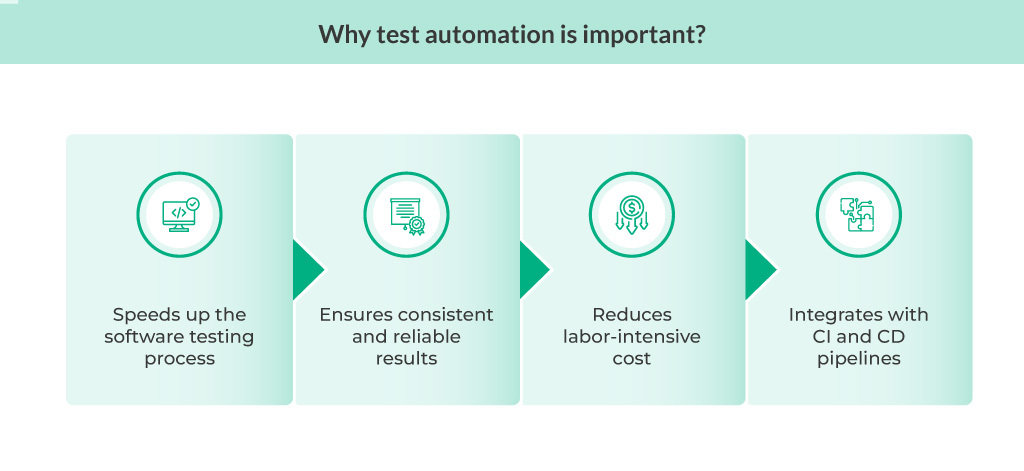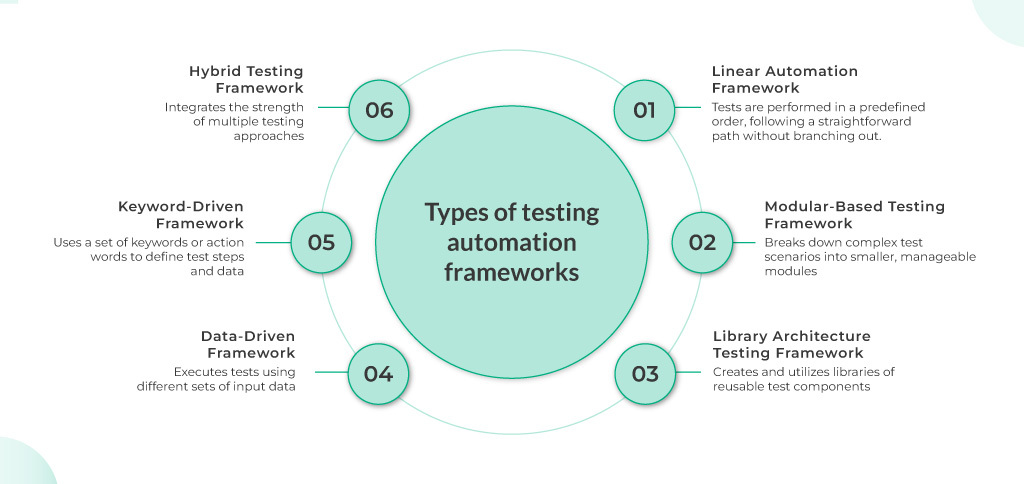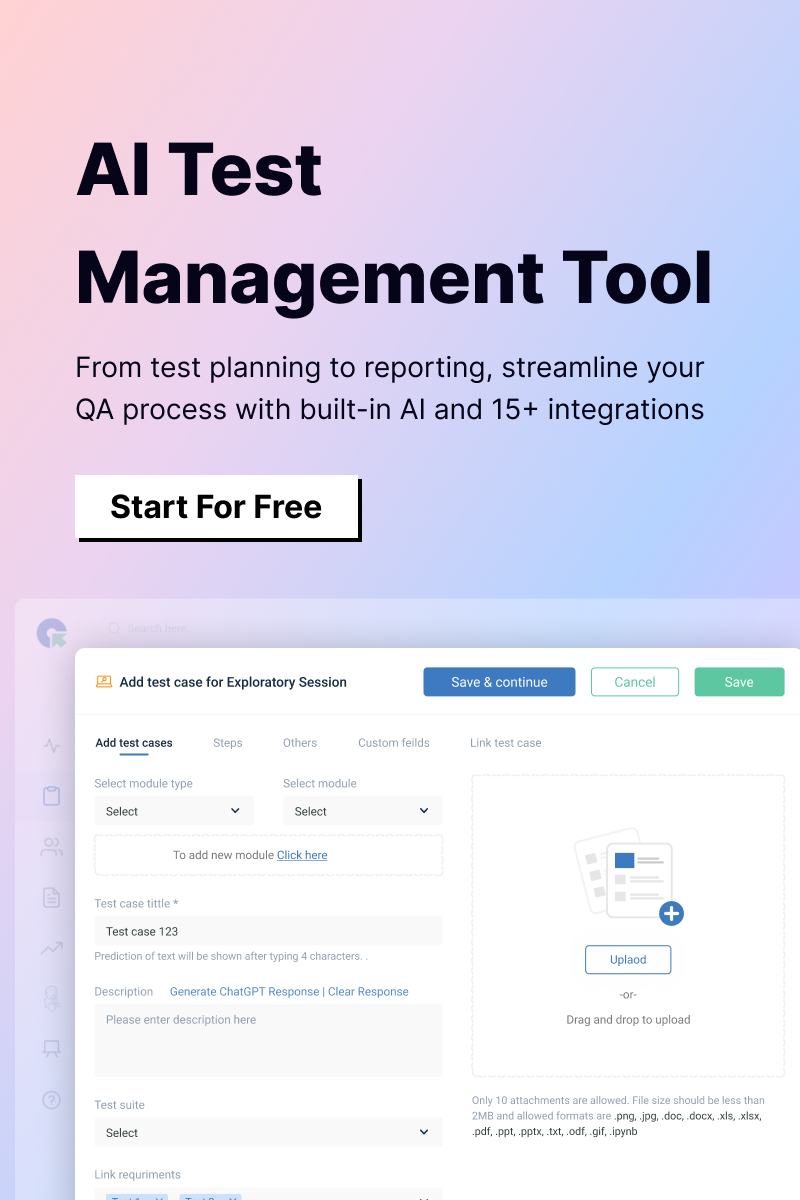A report suggests that Automated tests identify 70-80% of bugs found during the testing phase, giving testers an upper hand in detecting issues better, thereby saving costs and effort.
Although manual testing is still in practice, as applications become more complex, you need something more advanced. This is where automated testing frameworks come in.
These frameworks allow you to create, run, and manage tests more efficiently, ensuring high-quality software delivery. In this blog, we will learn about the six types of testing automation frameworks.
What is a Test Automation Framework?
A test automation framework is a set of guidelines, tools, and practices designed to help automate the process of testing software.
It provides a structured way to create, manage, and execute automated tests, making it easier to write consistent and reusable tests, maintain test scripts, and generate test reports. Think of it as a blueprint that helps developers and testers efficiently automate their testing tasks.
Importance of Testing Automation
Testing automation is crucial for keeping up with the demands of modern software development. Let’s break down why it’s so important:
Increased Efficiency and Speed
Imagine manually testing every aspect of a software application every time a change is made. It would be slow and incredibly time-consuming. Automated testing speeds up this process dramatically.
Tests can be run quickly and repeatedly, thus providing rapid feedback on whether everything is working as expected. This efficiency is vital when frequent updates and releases are the norm.
Improved Accuracy and Coverage
Manual testing can be prone to human error. People might overlook specific scenarios or make mistakes while executing tests.
Automated tests, on the other hand, follow precise instructions every time. They ensure consistent and reliable results, covering many test cases and edge conditions.
This comprehensive coverage reduces the risk of bugs slipping through unnoticed and appearing in the final product.
Cost Savings
Although setting up automated testing requires an initial investment of time and resources, it ultimately saves money in the long run.
Automated tests reduce the need for extensive manual testing, which can be labour-intensive and costly.
By catching issues early in the development process, organizations avoid the expenses associated with fixing bugs later, such as emergency patches or customer support escalations.
Continuous Integration and Delivery Support
Automated testing integrates seamlessly with continuous integration (CI) and continuous delivery (CD) pipelines. These practices emphasize frequent code changes and rapid deployment.
By automating tests within these pipelines, teams ensure that new code is thoroughly tested before it reaches production. This approach prevents integration issues and helps maintain the stability and reliability of the software throughout its lifecycle.

Criteria for Selecting a Testing Automation Framework
Before we jump into exploring specific testing automation frameworks, let’s understand what factors you should consider when choosing the right one for your needs. Here are the key criteria:
Ease of Use
First and foremost, the framework should be user-friendly. It should be easy for both developers and testers to set up, create tests, and interpret results without needing in-depth knowledge of programming.
A straightforward interface and clear documentation can make a world of difference in how quickly you can adopt and utilize the framework.
Compatibility with Different Technologies
Your testing framework needs to be versatile. It should support various technologies and platforms, whether you’re testing web applications, mobile apps, or embedded systems.
A framework that adapts to different environments ensures you can apply it across your entire range of projects without hitting compatibility roadblocks.
Reusability
Efficiency in testing comes from reusable components and scripts. A good framework should allow you to build modular tests that can be easily reused across different scenarios.
This saves time in test creation and ensures consistency and reliability across your testing suite.
Flexibility
No two projects are identical, so your testing framework should be flexible enough to accommodate different testing methodologies and approaches.
Whether you prefer script-based testing, keyword-driven testing, or behavior-driven testing, the framework should support your preferred style and adapt to changes in testing requirements over time.
Maintenance
As your application evolves, so should your tests. A good testing framework should make it easy to maintain and update your test scripts as your software changes.
It should provide tools and features that simplify test maintenance, reducing the overhead of keeping your tests aligned with your application updates.
Scalability
Whether you’re working on a small project or a large enterprise-level application, scalability is key.
Your testing framework should scale with your needs—handling a growing number of tests, users, and data volumes without compromising on performance or reliability.
Integration Capabilities
Integration with other tools and systems in your development pipeline is crucial for seamless workflows. Your testing framework should integrate smoothly with CI/CD tools, version control systems, and test management platforms.
This integration ensures that testing becomes an integral part of your development process rather than a standalone activity.
Cost
Last but not least, consider the cost implications. Some frameworks are open-source, offering cost savings on licensing fees, but may require more internal resources for support and maintenance.
Commercial frameworks may come with a price tag but often provide dedicated support, advanced features, and assurance of ongoing updates.
6 Popular Testing Automation Frameworks for 2025

Let’s now explore some of the leading testing automation frameworks in 2025, along with their unique features and capabilities:
Framework 1: Linear Automation Framework
The linear automation framework is designed to streamline the testing process by executing test cases in a linear sequence from start to finish. This approach ensures that tests are performed in a predefined order, following a straightforward path without branching out.
It is particularly effective for applications or scenarios where the workflow is predictable and does not involve complex decision-making paths.
- Tests are conducted in a sequential manner, maintaining a clear order of operations.
- Easy setup and minimal configuration are required to get started with testing.
- It provides a straightforward view of how tests are executed and their outcomes.
While primarily used for linear workflows, the linear automation framework can be effectively applied in scenarios such as basic UI testing, login/logout processes, and sequential data validation tasks.
Advantage: Simple to understand and implement, suitable for straightforward applications.
Disadvantage: Limited flexibility for testing complex scenarios that involve conditional logic or branching paths.
Framework 2: Modular-Based Testing Framework
The Modular-Based Testing Framework helps test automation by breaking down complex test scenarios into smaller, manageable modules. Each module focuses on independently testing a specific application functionality or component.
This approach enhances test scripts’ reusability, scalability, and maintainability, allowing teams to efficiently create and manage tests across different modules.
- Tests are divided into independent modules, making maintaining and reusing test scripts easier.
- This framework scales effectively with growing test suites and application complexity.
- Modules here can be combined in various configurations to create diverse test scenarios.
Advantage: Promotes code reusability, reduces redundancy in test scripts, and supports parallel testing.
Disadvantage: Requires initial planning and effort to establish module interactions and dependencies.
Ideal for applications with modular architectures, such as enterprise systems, where testing needs to cover various functional areas like user management, payment processing, and reporting modules.
Framework 3: Library Architecture Testing Framework
The Library Architecture Testing Framework revolves around creating and utilizing libraries of reusable test components. It emphasizes modularization and reusability to streamline the test creation and maintenance process.
Library architechture framework allows testers to build a repository of standardized test functions and methods, which can be easily accessed and reused across different test cases and projects.
- This framework centralizes test functions and methods into libraries for efficient reuse across multiple tests.
- It encourages the creation of independent test components that can be combined to create comprehensive test scenarios.
- The updates to test functionalities can be applied uniformly across all tests using the shared libraries.
Advantage: Promotes consistency in testing, reduces redundancy in test script creation, and accelerates test development.
Disadvantage: Initial setup and management of libraries require careful planning and coordination to ensure effective utilization.
This framework is suitable for projects where standardized test components can be leveraged across different applications or modules, such as API testing, regression testing, and integration testing.
Framework 4: Data-Driven Framework
The Data-Driven Framework enhances test automation by separating test scripts from test data. It allows testers to execute tests using different input data sets stored externally in spreadsheets or databases.
This approach improves test coverage, promotes reusability, and reduces maintenance efforts by decoupling test logic from data.
- This framework uses external data files (e.g., Excel sheets, CSV files) to drive test scenarios.
- It allows parameterization of test scripts to run with various input data sets.
- It separates test logic from test data, enhancing maintainability and scalability.
Advantages: Increases test coverage by running tests with diverse data sets, promotes reusability of test scripts, and facilitates easier maintenance.
Disadvantages: Requires careful management of test data sources and may involve initial setup complexity.
It is effective for applications with varying input scenarios, such as form validation, search functionalities, and user registration processes.
Framework 5: Keyword-Driven Framework
The Keyword-Driven Framework revolutionizes test automation by separating test design and implementation. It uses a set of keywords or action words to define test steps and data, abstracting technical details from test scripts.
This approach empowers testers with varying technical skills to create and execute tests efficiently by focusing on business logic rather than coding.
- It maintains a repository of keywords representing actions or operations to be performed.
- The test cases are structured using keywords, making them readable and understandable for non-technical stakeholders.
- It allows testers to create complex test scenarios by combining simple keywords.
- It promotes the reuse of keywords across different test cases and projects, enhancing efficiency.
Advantage: Enables non-programmers to contribute to test automation efforts
Disadvantage: Requires initial effort to understand and create the keyword library
The Keyword-Driven Framework is ideal for projects requiring frequent test modifications, such as agile environments. It effectively tests complex workflows and business logic scenarios, where tests need to be easily understandable and adaptable to changing requirements.
Also see: How to do agile testing?
Framework 6: Hybrid Testing Framework
The Hybrid Testing Framework integrates the strengths of multiple testing approaches, combining elements of different frameworks like keyword-driven, data-driven, and modular testing. This hybrid approach aims to leverage each methodology’s advantages while mitigating its limitations, offering flexibility and scalability in test automation.
- This framework allows for modular test design with reusable components.
- It combines keyword-driven, data-driven, and other methodologies to suit diverse testing needs.
- It helps scale effectively to handle large and complex test suites.
- The framework provides flexibility in defining and executing test scenarios.
Advantage: Covers a wide range of test scenarios and application functionalities
Disadvantage: Increased complexity in setup and maintenance compared to single-method frameworks.
The Hybrid Testing Framework is beneficial for projects with diverse testing requirements, such as enterprise applications with complex workflows, APIs with various input scenarios, and systems requiring integration testing across multiple modules.
Best Practices for Using Testing Automation Frameworks
There are certain practices that you can follow to optimize your use of testing automation frameworks and maintain high software quality:
Choosing the Right Framework for Your Needs
Selecting the appropriate testing automation framework is crucial.
You need to consider factors like ease of use, compatibility with your technology stack, support for different testing types (e.g., UI, API), and scalability to match your project’s growth.
A framework that aligns with your team’s skills and project requirements will streamline your testing process and maximize efficiency.
Keeping Tests Maintainable
Maintaining test cases is as vital as writing them. Ensure your test scripts are well-structured, readable, and modular.
Implement coding standards and documentation practices to facilitate easier updates and debugging.
Regularly refactor and optimize your tests to keep pace with application changes and evolving testing requirements.
Also see: How to write and manage test cases with QA Touch
Integrating with CI/CD Pipelines
Integrating testing automation into your CI/CD pipelines is essential for achieving continuous testing and delivery. You can automate the execution of tests as part of your build and deployment processes.
This integration ensures that defects are identified early, reducing the time and cost of fixing issues in later stages. It also promotes faster delivery of quality software to production.
Leveraging Community and Support Resources
Tap into the power of community and support resources offered by your chosen framework. Engage in forums, attend webinars, and participate in user groups to exchange knowledge, troubleshoot issues, and discover best practices.
Leverage vendor support for timely resolution of critical problems and access to updates that enhance framework capabilities.
Regularly Reviewing and Updating Test Cases
Review and update your test cases regularly to ensure they reflect the current application functionality and user workflows. Validate test coverage against new features and changes in requirements.
Incorporate feedback from stakeholders to refine test scenarios and enhance test effectiveness. Continuous improvement of test cases ensures they remain relevant and reliable throughout the software development lifecycle.
Conclusion
Automation frameworks excel in establishing reliable and sustainable automated tests that can be easily reused. They significantly reduce the time and effort invested in testing processes, thereby enabling businesses to achieve cost savings, enhance quality, and drastically minimize manual testing efforts.
QA Touch is an effective test management platform that integrates all testing stages into one workspace, enabling seamless planning, test creation, organization into suites, execution across environments, and report generation.
Start your 14-day free trial to see how it works.













